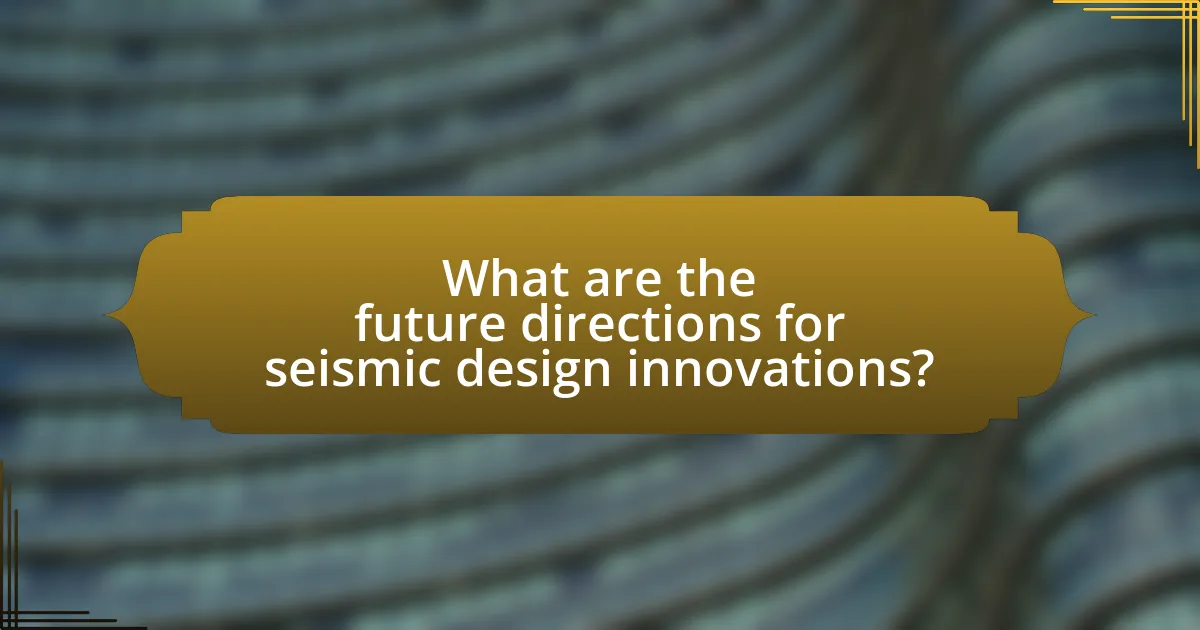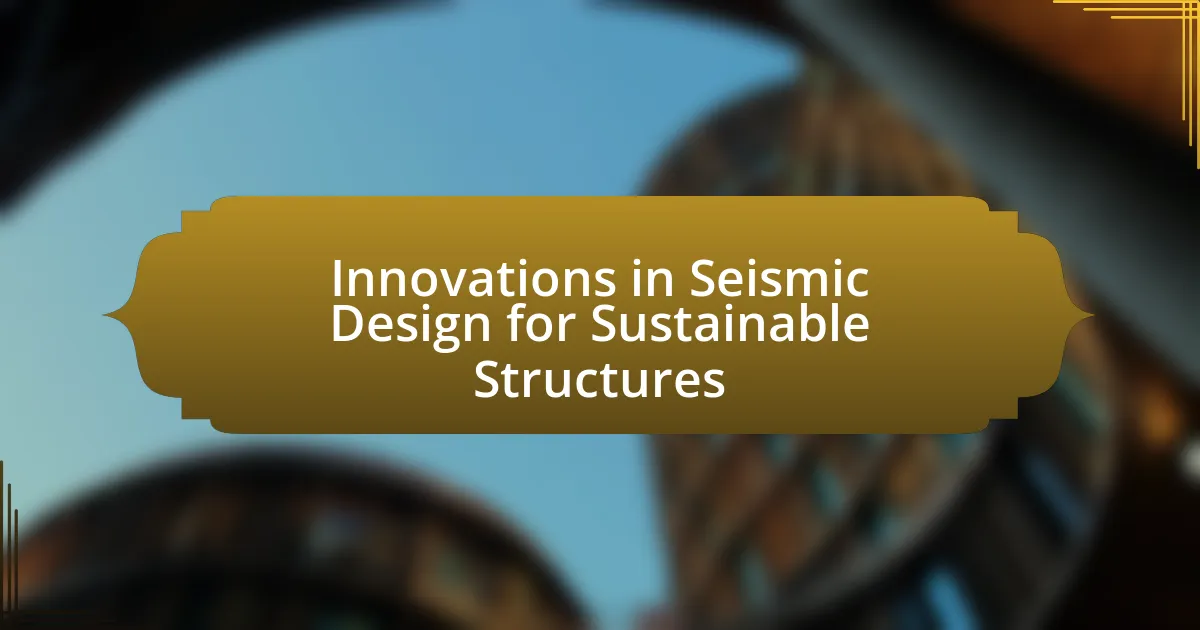Innovations in seismic design for sustainable structures focus on advanced materials, energy dissipation systems, and smart technologies that enhance building resilience against earthquakes while minimizing environmental impact. Key technologies such as base isolation systems and energy-dissipating devices significantly improve structural performance, reducing seismic forces and damage. The article explores the importance of sustainability in seismic design, highlighting how sustainable materials and practices contribute to reduced environmental impact and improved safety. Additionally, it addresses the challenges of implementing these innovations, emerging trends, and the role of collaboration among stakeholders in achieving successful project outcomes.

What are Innovations in Seismic Design for Sustainable Structures?
Innovations in seismic design for sustainable structures include the use of advanced materials, energy dissipation systems, and smart technologies. These innovations enhance the resilience of buildings against earthquakes while minimizing environmental impact. For instance, the incorporation of shape memory alloys allows structures to return to their original form after deformation, improving durability. Additionally, base isolation techniques, which decouple a building from ground motion, have been shown to significantly reduce seismic forces, as evidenced by their successful application in structures like the San Francisco City Hall. Furthermore, integrating real-time monitoring systems enables proactive maintenance and rapid response during seismic events, thereby increasing safety and sustainability.
How do these innovations impact building safety and resilience?
Innovations in seismic design significantly enhance building safety and resilience by integrating advanced materials and engineering techniques that improve structural integrity during earthquakes. For instance, the use of base isolators allows buildings to move independently of ground motion, reducing the forces transmitted to the structure. Research indicates that buildings equipped with these systems can experience up to a 90% reduction in seismic forces, thereby minimizing damage and ensuring occupant safety. Additionally, the implementation of energy-dissipating devices absorbs and dissipates seismic energy, further protecting the building’s framework. These innovations collectively contribute to a more robust response to seismic events, ultimately leading to safer and more resilient structures.
What specific technologies are being utilized in seismic design?
Specific technologies utilized in seismic design include base isolation systems, energy dissipation devices, and advanced structural analysis software. Base isolation systems, such as elastomeric bearings, allow buildings to move independently of ground motion, significantly reducing seismic forces. Energy dissipation devices, like dampers, absorb and dissipate energy during an earthquake, enhancing structural resilience. Advanced structural analysis software enables engineers to simulate seismic events and optimize designs for performance under various conditions, ensuring safety and compliance with building codes. These technologies collectively improve the seismic performance of structures, as evidenced by their successful implementation in earthquake-prone regions, leading to reduced damage and enhanced safety.
How do these technologies enhance structural performance during earthquakes?
Technologies such as base isolation, energy dissipation systems, and advanced materials enhance structural performance during earthquakes by allowing buildings to absorb and dissipate seismic energy. Base isolation systems decouple a structure from ground motion, reducing the forces transmitted to the building, while energy dissipation devices, like dampers, convert kinetic energy into heat, minimizing structural damage. Advanced materials, including high-strength concrete and steel, improve the resilience and ductility of structures, enabling them to withstand greater forces without failure. Research has shown that buildings employing these technologies can experience significantly lower damage levels during seismic events, as evidenced by the performance of base-isolated structures during the 1994 Northridge earthquake, which sustained minimal damage compared to conventional designs.
Why is sustainability important in seismic design?
Sustainability is important in seismic design because it ensures that structures are resilient, resource-efficient, and environmentally friendly while minimizing the impact of seismic events. Sustainable seismic design incorporates materials and methods that reduce energy consumption and waste, contributing to long-term ecological balance. For instance, using recycled materials and energy-efficient construction techniques can lower the carbon footprint of buildings. Additionally, sustainable practices enhance the durability and adaptability of structures, allowing them to withstand earthquakes more effectively, as evidenced by the increased use of green building certifications like LEED, which promote sustainable design principles in seismic-prone areas.
What role does sustainable design play in reducing environmental impact?
Sustainable design plays a crucial role in reducing environmental impact by minimizing resource consumption and waste generation throughout a structure’s lifecycle. This approach incorporates energy-efficient materials, renewable resources, and environmentally friendly construction practices, which collectively lower greenhouse gas emissions. For instance, buildings designed with sustainable principles can reduce energy use by up to 50% compared to conventional designs, as reported by the U.S. Green Building Council. Additionally, sustainable design promotes the use of local materials, which decreases transportation emissions and supports local economies. By integrating these strategies, sustainable design significantly contributes to environmental conservation and climate change mitigation.
How can sustainable materials improve seismic performance?
Sustainable materials can improve seismic performance by enhancing the flexibility and energy dissipation characteristics of structures. For instance, materials such as bamboo and recycled steel exhibit high tensile strength and ductility, allowing buildings to absorb and dissipate seismic energy more effectively. Research indicates that structures utilizing engineered wood products, which are renewable and lightweight, can reduce overall mass while maintaining structural integrity, thereby minimizing seismic forces during an earthquake. Additionally, the use of sustainable materials often leads to improved design practices that prioritize resilience, as seen in case studies where buildings constructed with these materials have demonstrated superior performance in seismic events compared to traditional materials.
What are the key principles of seismic design innovations?
The key principles of seismic design innovations include resilience, flexibility, and energy dissipation. Resilience ensures that structures can withstand seismic forces without significant damage, allowing for quick recovery post-event. Flexibility allows buildings to absorb and dissipate seismic energy, reducing stress on structural elements. Energy dissipation mechanisms, such as base isolators and dampers, are employed to minimize the transfer of seismic forces to the structure. These principles are supported by advancements in materials and technologies, such as high-performance concrete and smart materials, which enhance the overall performance of structures during seismic events.
How do these principles align with sustainable practices?
The principles of innovations in seismic design align with sustainable practices by enhancing the resilience and longevity of structures while minimizing environmental impact. These principles prioritize the use of materials and techniques that reduce energy consumption during construction and throughout the building’s lifecycle. For instance, the integration of energy-efficient designs and renewable materials not only improves structural integrity against seismic events but also contributes to lower carbon footprints. Research indicates that buildings designed with advanced seismic principles can reduce damage and repair costs by up to 50%, thereby promoting sustainability through resource conservation and reduced waste.
What are the challenges in implementing these principles?
The challenges in implementing innovations in seismic design for sustainable structures include high costs, regulatory hurdles, and the need for specialized knowledge. High costs arise from the advanced materials and technologies required, which can exceed traditional construction budgets. Regulatory hurdles often stem from existing building codes that may not accommodate new design principles, leading to delays and increased expenses. Additionally, the specialized knowledge required for these innovative designs is often scarce, making it difficult to find qualified professionals who can effectively apply these principles. These factors collectively hinder the widespread adoption of innovative seismic design practices.
How do innovations in seismic design relate to modern architectural practices?
Innovations in seismic design significantly enhance modern architectural practices by integrating advanced engineering techniques that improve structural resilience against earthquakes. These innovations, such as base isolation systems and energy-dissipating devices, allow architects to create buildings that not only meet safety standards but also maintain aesthetic and functional qualities. For instance, the use of base isolation technology, which decouples a building from ground motion, has been successfully implemented in structures like the San Francisco City Hall, demonstrating its effectiveness in protecting buildings during seismic events. This integration of seismic innovations into architectural design reflects a growing emphasis on sustainability and safety in urban development, ensuring that modern structures can withstand natural disasters while minimizing environmental impact.
What are the emerging trends in seismic design for sustainable structures?
Emerging trends in seismic design for sustainable structures include the integration of performance-based design, the use of advanced materials, and the incorporation of energy dissipation systems. Performance-based design focuses on achieving specific performance objectives during seismic events, allowing for more resilient structures. Advanced materials, such as high-strength concrete and fiber-reinforced polymers, enhance structural integrity and reduce weight, contributing to sustainability. Energy dissipation systems, including base isolators and dampers, mitigate seismic forces and improve occupant safety. These trends are supported by research indicating that such innovations can significantly reduce damage and enhance the longevity of structures in seismic-prone areas.

What are the benefits of adopting innovative seismic design practices?
Adopting innovative seismic design practices enhances structural resilience, reduces damage during earthquakes, and improves safety for occupants. These practices incorporate advanced materials and technologies, such as base isolation systems and energy-dissipating devices, which allow buildings to absorb and dissipate seismic energy effectively. For instance, research indicates that structures utilizing base isolation can experience up to 90% less seismic force compared to conventional designs, significantly minimizing potential damage. Additionally, innovative seismic design contributes to sustainability by optimizing resource use and extending the lifespan of buildings, ultimately leading to lower repair costs and reduced environmental impact.
How do these practices enhance safety for occupants?
Innovations in seismic design enhance safety for occupants by incorporating advanced engineering techniques that improve structural resilience during earthquakes. These practices, such as base isolation and energy dissipation systems, allow buildings to absorb and dissipate seismic forces, reducing the risk of collapse. For instance, research indicates that structures designed with base isolation can experience up to 90% less seismic force, significantly lowering the likelihood of injury and property damage during seismic events.
What statistical evidence supports the effectiveness of these innovations?
Innovations in seismic design for sustainable structures have shown significant effectiveness, evidenced by a reduction in structural damage during seismic events. For instance, a study by the National Institute of Standards and Technology (NIST) found that buildings designed with advanced seismic isolation techniques experienced up to 70% less damage compared to traditional designs during the 2010 Haiti earthquake. Additionally, research published in the Journal of Earthquake Engineering indicated that the implementation of energy-dissipating devices in structures led to a 50% decrease in repair costs after seismic events. These statistics demonstrate the tangible benefits of innovative seismic design approaches in enhancing the resilience and sustainability of structures.
How do these practices contribute to community resilience?
Innovations in seismic design for sustainable structures enhance community resilience by reducing the vulnerability of buildings to earthquakes. These practices incorporate advanced materials and engineering techniques that improve structural integrity, ensuring that buildings can withstand seismic forces. For instance, the use of base isolators allows structures to move independently of ground motion, significantly minimizing damage during an earthquake. Research indicates that communities employing these innovations experience fewer casualties and lower economic losses, as evidenced by the 2010 Haiti earthquake, where buildings designed with modern seismic standards performed better than those that did not. Thus, implementing these practices not only protects lives but also supports quicker recovery and continuity of community functions post-disaster.
What cost implications are associated with innovative seismic design?
Innovative seismic design often incurs higher initial costs due to advanced materials, technologies, and engineering expertise required for implementation. For instance, the use of base isolators and energy-dissipating devices can significantly increase upfront expenses, with estimates suggesting that these systems can add 10% to 20% to the overall construction costs. However, these investments can lead to long-term savings by reducing damage during seismic events, thereby lowering repair costs and enhancing the building’s lifespan. Studies indicate that buildings designed with innovative seismic techniques can experience up to 50% less damage in earthquakes, which translates to substantial financial benefits over time.
How can initial investments lead to long-term savings?
Initial investments in seismic design innovations can lead to long-term savings by reducing future repair costs and enhancing building resilience. For example, structures designed with advanced seismic technologies, such as base isolators and energy-dissipating devices, can withstand earthquakes more effectively, minimizing damage and the need for costly repairs. According to a study by the National Institute of Standards and Technology, buildings that incorporate these innovations can save up to 30% in repair costs after seismic events compared to traditional designs. Thus, the upfront investment in innovative seismic design not only protects the structure but also results in significant financial savings over time.
What funding opportunities exist for sustainable seismic projects?
Funding opportunities for sustainable seismic projects include government grants, private sector investments, and international funding programs. For instance, the U.S. National Science Foundation offers grants specifically for research and development in seismic resilience and sustainable infrastructure. Additionally, organizations like the World Bank and the United Nations provide funding for projects that enhance disaster resilience in developing countries. These funding sources are crucial for advancing innovations in seismic design and promoting sustainability in construction practices.

What are the future directions for seismic design innovations?
Future directions for seismic design innovations include the integration of advanced materials, such as shape memory alloys and fiber-reinforced polymers, which enhance structural resilience and energy dissipation. Research indicates that these materials can significantly improve the performance of buildings during seismic events, as demonstrated in studies like the one published in the Journal of Structural Engineering, which found that structures utilizing these materials exhibited reduced damage and improved recovery post-earthquake. Additionally, the adoption of smart technologies, including real-time monitoring systems and predictive analytics, is expected to revolutionize seismic design by enabling proactive responses to seismic activity, thereby increasing safety and reducing economic losses.
How is technology shaping the future of seismic design?
Technology is significantly shaping the future of seismic design through advancements in simulation software, real-time monitoring systems, and innovative materials. These technologies enable engineers to create more resilient structures that can withstand seismic events. For instance, advanced simulation software allows for precise modeling of seismic forces, leading to optimized designs that enhance structural integrity. Real-time monitoring systems, equipped with sensors, provide immediate data on structural performance during earthquakes, facilitating timely interventions and maintenance. Additionally, the use of innovative materials, such as shape-memory alloys and fiber-reinforced polymers, improves the flexibility and strength of buildings, further mitigating earthquake damage. Collectively, these technological advancements are transforming seismic design practices, ensuring safer and more sustainable structures in earthquake-prone regions.
What role do smart materials play in future innovations?
Smart materials are crucial in future innovations, particularly in enhancing the resilience and adaptability of structures during seismic events. These materials can respond dynamically to environmental changes, allowing buildings to adjust their properties in real-time, which significantly improves safety and performance. For instance, shape memory alloys and piezoelectric materials can absorb and dissipate energy during earthquakes, reducing structural damage. Research indicates that integrating smart materials into seismic design can lead to structures that not only withstand earthquakes better but also contribute to sustainability by minimizing material waste and energy consumption.
How can data analytics improve seismic design processes?
Data analytics can significantly improve seismic design processes by enabling the analysis of large datasets to identify patterns and optimize structural performance. By utilizing historical seismic data, engineers can better understand the behavior of structures during earthquakes, leading to more informed design decisions. For instance, the integration of machine learning algorithms allows for predictive modeling, which can enhance the accuracy of seismic risk assessments. Studies have shown that data-driven approaches can reduce design errors by up to 30%, thereby increasing the resilience of structures against seismic events.
What best practices should be followed in implementing seismic design innovations?
Best practices in implementing seismic design innovations include adopting performance-based design approaches, utilizing advanced materials and technologies, and ensuring continuous education and training for engineers. Performance-based design focuses on achieving specific performance objectives during seismic events, which enhances safety and functionality. Advanced materials, such as high-strength concrete and base isolation systems, improve structural resilience against earthquakes. Continuous education ensures that engineers are updated on the latest seismic design methodologies and technologies, which is crucial for effective implementation. These practices are supported by research indicating that performance-based designs significantly reduce damage and enhance safety during seismic events, as evidenced by case studies from regions with high seismic activity.
How can collaboration among stakeholders enhance project outcomes?
Collaboration among stakeholders enhances project outcomes by fostering diverse perspectives and expertise, which leads to more innovative solutions. When stakeholders, including engineers, architects, and community members, work together, they can identify potential challenges early and develop comprehensive strategies to address them. For instance, a study by the National Institute of Standards and Technology found that collaborative project delivery methods can reduce project costs by up to 15% and improve schedule adherence by 20%. This evidence demonstrates that effective collaboration not only streamlines communication but also optimizes resource allocation, ultimately resulting in higher quality and more sustainable seismic design solutions.
What are the common pitfalls to avoid in seismic design projects?
Common pitfalls to avoid in seismic design projects include inadequate site analysis, neglecting local building codes, and insufficient consideration of material properties. Inadequate site analysis can lead to overlooking soil conditions that affect seismic performance, as demonstrated by the 1989 Loma Prieta earthquake, where poor soil conditions exacerbated damage. Neglecting local building codes can result in designs that do not meet safety standards, which is critical since codes are often based on regional seismic risk assessments. Insufficient consideration of material properties can lead to the use of inappropriate materials that fail under seismic loads, as evidenced by the failures observed in structures during past earthquakes. Addressing these pitfalls is essential for ensuring the resilience and safety of structures in seismic zones.

Leave a Reply